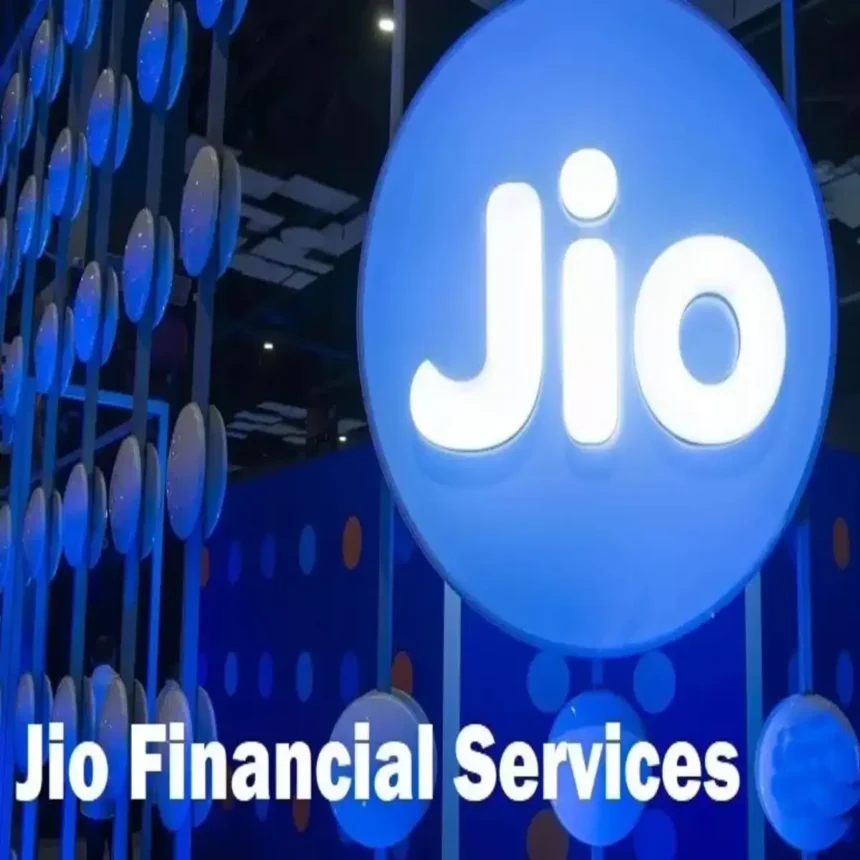Introduction
Jio Financial Services (JFS) could be the most recent name on Dalal Street, but its lineage is deep—deep into the core of Reliance Industries, India’s strongest business empire. Hived off from Reliance in 2023, JFS was set up to shake up and dominate India’s fast-changing financial services space, just like Jio shook up the telecommunications industry.

At the nexus of tech, money, and access for the masses, JFS combines Reliance’s millions of customers, digital backbone, and financial aspirations. And what’s its aim? To provide a complete stack of services—lending, insurance, payments, and asset management—every one of them digital, all under a single roof.
But it’s the Q2 FY2026 results that have popped JFS into the investor limelight in a flash. With net profits increasing more than double and strategic alliances unfolding, market observers now wonder: Is this only the start of another Jio-style disruption?
“Jio isn’t just about telecom anymore—it’s rewriting the rules of finance too.”
Q2 FY2026 Highlights: Snapshot
Jio Financial Services posted a Q2 FY2026 blockbuster performance, surprising the analysts and indicating robust operational momentum. A glance at the figures that have raised everyone’s eyebrows:
Key Financial Metrics
| Metric | Q1 FY2026 | Q2 FY2026 | QoQ Growth (%) |
| Total Revenue | ₹416.44 crore | ₹486.57 crore | +16.8% |
| Operating Profit | ₹254.73 crore | ₹340.50 crore | +33.6% |
| Net Profit (PAT) | ₹324.66 crore | ₹689.07 crore | +112.2% |
| EPS (Diluted) | ₹0.52 | ₹1.10 | +111.5% |
What Stands Out?
- Double-digit topline growth: At ₹486.57 crore, overall income jumped close to 17% QoQ, led by growth in lending activity, digital financial services, and investment returns.
- Operating profit rose 33.6%, driven by improved cost efficiencies, technology-driven scalability, and margin increase.
- The net profit more than doubled, increasing by 112.2%, mainly because of increased interest income and the lack of one-off expenses that affected the last quarter.
- Earnings per share (EPS) also rose sharply to ₹1.10 from ₹0.52, showing improved returns to shareholders.
Q1 vs Q2: A Turnaround Story
While Q1 FY2026 indicated stability, Q2 is the turning point. The company not only expanded into the top line but posted disproportionately greater bottom-line growth, a hallmark indicator of operational leverage taking hold.
This traction also enhances faith in JFS’s overall strategy of digitizing financial services and taking share in underserved segments through its mobile-first platforms.
Deep Dive: Financial Performance
Jio Financial Services’ (JFS) Q2 performance wasn’t merely strong—nay, it was strategically impressive. If one peels beneath the headline figures, then one can see how well the company is set up for growth in the long term.
- Revenue Growth Drivers
JFS’s revenue grew to ₹486.57 crore during Q2 FY2026, a ~17% QoQ increase. Three pillars mainly drove this growth:
Lending Services:
The firm is scaling up its online lending products, especially for small-ticket personal and merchant loans. With interoperability into the Jio ecosystem (JioMart, JioRetail), credit disbursement is becoming quicker and more directed, particularly in Tier 2 & 3 cities.
Asset Management Progress
With its JV with BlackRock, JFS has already received SEBI approval to introduce mutual funds with a passive investment orientation (such as Nifty Next 50 and Smallcap 250).
Digital Platforms (JioFinance App):
The new super-app, introduced recently, is witnessing early momentum for bill payments, insurance discovery, and comparison of financial products. Though monetization is slow, it enhances JFS’s recall and customer acquisition.
- Net Profit Spurt: Why Did It Double?
The net profit of the company rose from ₹324.66 crore in Q1 to ₹689.07 crore in Q2 — a 112% increase. The main reasons are:
Increased Interest Income:
As the loan book increased and interest-generating assets increased, JFS recorded more income from its financing operations.
Low Base Effect:
Q1 was affected by specific one-off setup and compliance-related expenses (post demerger). Having those behind, Q2 witnessed normalized profitability.
Minimal Credit Costs:
As a new entrant, JFS has a fairly “clean” loan book, with minimal non-performing assets (NPAs) to date. That implied minimum provisioning, which helped inflate PAT.
- Operating Margin Expansion
JFS achieved an operating profit of ₹340.50 crore, representing 70–75% margins. That’s higher than ~69% in Q1, indicating:
- Improved cost discipline in distribution and tech infrastructure
- Economies of scale due to picking up volumes
- Reduced customer acquisition costs through Reliance’s existing base (Jio, Reliance Retail)
- Cost Management & Interest Expenses
While revenues soared, costs were strictly controlled. The firm is benefiting from:
- Shared infrastructure with Reliance,
- Digital-only customer onboarding
- Minimal dependence on physical branches or intermediaries.
Interest costs increased moderately as a result of borrowing expansion, but were contained. JFS is debt-light now and employing internal accruals + equity infusion (₹15,825 crore through warrants) to finance growth rather than expensive loans.
Jio Financial’s Q2 numbers weren’t a one-off recovery—instead, they show a well-designed, digitally enabled business model that is now starting to grow.
Strategic Moves & Business Expansion
JFS isn’t surfing on quarterly numbers—it’s constructing a long-term growth engine driven by strategic capital deployment, regulatory stability, and digital-first strategies.
- Capital Infusion through ₹15,825 Crore Warrants
In July 2025, the JFS board authorized a gargantuan capital raise of ₹15,825 crore through the issuance of warrants to Reliance Industries Limited (RIL).
- Warrant Price: ₹316.50 per share
- Conversion Window: 18 months from allotment
- Objective: Support business growth in lending, insurance broking, leasing, and digital infrastructure.
This action fortifies the balance sheet of the company, providing it with sufficient liquidity without having to incur debt immediately. Though this can cause dilution when converted, it also gives JFS the war chest it needs to fight against deep-rooted players such as Bajaj Finance or Paytm in fintech.
- Jio-BlackRock AMC Approval & Product Lineup
- JFS’s joint venture with international investment behemoth BlackRock got regulatory approval from SEBI to introduce a series of index-based mutual funds.
- Target audience: New investors, millennials, and passive investors
- Product range: Nifty Midcap 150, Nifty Next 50, Smallcap 250 index funds, and others
- Digital Finance Growth through JioFinance App
- The JioFinance super-app is the hub of JFS’s fintech aspirations.
- Services provided: Bill payment, insurance discovery, personal loans, EMI financing, and ultimately stock investing.
- Target customer bases: Jio’s behemoth mobile subscriber base, JioMart customers, and unserved rural/semi-urban consumers.
- Imagine it as a “Paytm meets Google Pay with the brawn of Reliance”—but laser-sharp on creating a clean, scalable, and compliant financial ecosystem.
The backend of the app is designed for scale, with onboarding, credit vetting, and transactions being AI-powered and paperless.
- Shift Towards Core Investment Company (CIC) Status
- JFS has sought regulatory transition to an NBFC-to-CIC structure.
- When approved, this status would potentially formally make JFS a full-spectrum financial holding company, setting the stage for consolidation and more focused strategic intent.
- Jio Financial is not only joining India’s fintech sprint—it’s preparing the runway for decades-long supremacy. JFS is establishing itself as a formidable, tech-first financial giant with deep pockets and broad reach.
Market Sentiment & Valuation
- Target Prices
KR Choksey upgraded its view recently to a “Buy” and increased its 12-month price target to approximately ₹345, based on sustained strength following warrants approval and robust Q2 momentum. Analyst consensus across other brokerage reports is more conservative, with average price targets around ₹300–₹318, implying modest downside (~3%–4% below existing levels)
Concurrently, global estimates (say, from Investing.com or AlphaSpread) show a bearish picture. Their 1-year target is in the region of ₹270–₹280, suggesting up to ~17% fall from here (~₹333) While there may be potential for near-term appreciation to ₹345–380 as per some analysts, the general view is one of a neutral to cautious stance, awaiting sustained earnings growth and conversion clarity.
- Stock Performance Post-Q2 Results
- After Q2 results, JFS moved within the ₹327–₹333 range, range-bound since late June.
- In the last 6 months, the stock has registered a healthy ~31% gain, albeit its 1‑year return of about +5%, an indication of its recent market listing in mid‑2023
- Technical analysts on sites such as StockTwits point to good support in the ₹305–₹293 zone with short‑term targets for the upside ranging from ₹355 to ₹380 if the bullish run continues.
- Valuation Metrics: P/E, P/B & Relative Comparison
- On August 5–6, 2025, JFS is available at a Price-to-Earnings (TTM) multiple of ~130×, which puts it close to multi‑year highs and significantly above industry standards.
- For perspective, Indian diversified financials’ average P/E is in the 24×28× range, placing Jio’s valuation more than 4× above peers such as Bajaj Finance, Muthoot Finance, or Shriram Finance.
- JFS commands a premium valuation, fueled by the growth potential perceived, Reliance sponsorship, and future monetization of its AMC business and lending portfolio.
- Yet with its early-stage profits and new-concept businesses, investors need conviction in future execution and expansion before warranting the steep multiples.
Key Takeaways
- The market has a neutral consensus, with some short-term bullish indicators but conservative longer-term price targets.
- JFS comes at a significant valuation premium, most deservedly supported by investor conviction in its size potential, but just as vulnerable to downside risks in case of decelerating growth.
- Future drivers—such as AMC product launch success, warrant conversions, CIC status approval, and ongoing loan book expansion—will prove pivotal in tipping sentiment one way or the other.
Future Growth Potential
JFS might be in the early innings, but its growth plan outlines a multi-vertical, digitally scaled financial giant in the making. Leveraging Reliance’s gargantuan ecosystem at its back, JFS is well poised to grow aggressively on multiple fronts.
- Critical Levers of Growth
JFS is going into under-penetrated lending categories such as:
- Small personal loans
- Buy Now Pay Later (BNPL)
- Merchant working capital
- With AI and digital KYC, the business can underwrite and onboard at scale, particularly in semi-urban and rural geographies.
Mutual Funds through Jio-BlackRock
- The AMC venture is addressing India’s growth mutual fund sector, which hit ₹55 lakh crore AUM in 2025.
- Concentrated on passive index funds—low-expense, first-time investor-friendly offerings
- The JV combines global know-how (BlackRock) and domestic digital distribution (Jio)
Digital Payments & Wallets
The JioFinance app offers:
- Bill payments
- UPI services
- Future potential for credit cards, EMI provides.
- Paced to compete with Paytm, PhonePe, and Google Pay—secured by trust and size
Insurance Broking
JFS has gone into insurance broking, distributing life and general insurance products through app integration
Ability to expand as a digital insurance aggregator, particularly for health, motor, and term policies
- Power of Cross-Selling within Reliance Ecosystem
One of JFS’s strengths is access to more than 450 million Jio consumers, 20,000+ Reliance Retail stores, and Kirana partners in the millions. Such platforms provide:
- Data-driven product targeting: Telco or retail behavior-driven credit scoring
- Seamless distribution: Customers can be onboarded at retail stores or Jio SIM activations
- Built-in trust: The Reliance brand has credibility in Bharat and Tier-2/3 towns
Synergy examples:
- JioMart customers are being offered embedded credit or insurance promotions.
- Retail consumers provided EMI financing during checkout.
- Jio users handling bills, loans, and investments—all within a single app
- Risks to Monitor
- Dilution Risk due to Warrants
- When Reliance exercises all the warrants (₹15,825 crore), the equity base increases, reducing EPS in the short run
- Investors need to balance the advantages of growth capital against near-term dilution.
Regulatory & Licensing Complexity
As JFS shifts to a Core Investment Company (CIC) status, it has to abide by RBI guidelines that could:
- Restrict direct lending except through subsidiaries.
- Demand more robust capital adequacy cushions.
High Competition
JFS enters competitive spaces led by:
- Bajaj Finance (loans)
- Paytm & PhonePe (payments)
- Zerodha, Groww (investments)
- Policybazaar (insurance)
- Speed of execution and digital UX will be key differentiators.
Comparison with Peers
As Jio Financial Services (JFS) branches out, it’s moving into territory already occupied by heavyweights such as Bajaj Finance, Paytm, and IDFC First Bank. This is how it stacks up—and how it’s different.
- JFS vs. Bajaj Finance
| Parameter | JFS | Bajaj Finance |
| Business Model | Digital-first NBFC + fintech | Traditional NBFC with digital arms |
| Loan Book | Early-stage | ₹3.2 lakh crore+ |
| Profitability | High margin, early profits | Proven, consistent profitability |
| Reach | Reliance ecosystem (Jio, Retail) | Pan-India, deep rural presence |
| Tech/UX | App-led model from Day 1 | Legacy with ongoing digital shift |
Bajaj Finance is the gold standard of success, but JFS may grow quicker because of technological and ecosystem strengths.
- JFS vs. Paytm (One97 Communications)
| Parameter | JFS | Paytm |
| Core Focus | Lending, AMC, insurance | Payments, commerce, lending |
| App Ecosystem | New but rapidly growing | Established, 300M+ users |
| Financial Strength | Backed by Reliance + fundraise | Facing profitability pressure |
| Regulatory Standing | Clean, new license holder | Under scrutiny post-Paytm Payments Bank issues |
Paytm is an experienced digital player, but now faces regulatory and trust issues. JFS can leverage this with a fresh start and rich funding.
- JFS vs. IDFC First Bank
| Parameter | JFS | IDFC First Bank |
| Type | NBFC (soon CIC) | Scheduled Commercial Bank |
| Capital Base | Equity-led | Mix of deposits and capital market |
| Lending Model | Digital retail focus | Broad lending: retail + infra loans |
| Profitability | Early-stage, high margins | Recently turned profitable |
IDFC First is a full-service bank with retail momentum, but JFS can remain agile with a digital-only business and no physical legacy.
What Sets JFS Apart?
- Reliance Ecosystem: No peer has access to 450M+ Jio users, 20,000+ retail outlets, and an integrated tech + logistics + consumer base.
- Fresh Capital: ₹15,825 crore through warrants gives dry powder for rapid expansion, without upfront debt or dilution.
- Global Partnerships: The Jio-BlackRock JV provides a ready platform in mutual funds, which most peers have accumulated over the years.
- Brand Trust + Distribution: Trust is essential in India. And Reliance has established that over the years, so JFS naturally has an upper hand even in traditional financial markets.
Conclusion
Jio Financial Services emerged swinging in Q2 FY2026, with robust revenue growth and doubling its net profit more than twice over. But for all the numbers, what impresses is its grand ambitions and strategic vision. Whether it’s raising new capital, foraying into asset management with a global partner, or rolling out a super-app to get financing at the fingertips of millions, JFS is playing for the long run.
Yes, its valuations are high, and competition is intense. But so was the situation when Jio ventured into telecom. Backed by Reliance, a vast distribution network, and a digital-first approach, JFS is looking not only to play a part in India’s fintech revolution but also to lead it.
In a conventional finance world, Jio Financial is thinking digital, going at high speed, and playing big. If it gets it right, this may be the next significant disruption from the Reliance stable.
FAQs
- What is Jio Financial Services?
JFS is the financial subsidiary of Reliance Industries, established to tap into India’s fast-expanding fintech and NBFC opportunities. It is concentrated on lending, asset management, insurance, and digital financial services.
- Why were the Q2 FY2026 results significant?
Q2 was a milestone quarter with high profit growth, infusion of capital, and impressive expansion announcements, indicating JFS’s seriousness in becoming a serious financial contender.
- How was the performance of JFS in Q2 FY2026?
JFS saw a substantial rise in net profit (₹312 crore) and sustainable revenue growth, with better operating margins and low-cost operations.
- What industries are contributing to JFS’s revenue?
Consumer and SME lending, digital payments, and the expanding asset management business through the Jio-BlackRock JV are the key revenue drivers.
- What is the Jio-BlackRock joint venture?
It is a 50:50 joint venture to venture into India’s mutual fund market. SEBI has recently approved it and is likely to introduce low-cost investment options for the masses.
- Why is the ₹15,825 crore capital raise important?
This capital raise gives us more than enough growth capital without any debt overhang in the immediate term. It will go towards lending growth, technology building, and potential acquisitions.
- In what way is JFS different from Paytm or Bajaj Finance?
While Paytm (payment-centric) and Bajaj Finance (legacy NBFC) lack digital-first DNA, access to the Reliance ecosystem, and new capital, JFS is placed particularly well for scale.
- What does the role of the JioFinance app involve?
The app is planning to be a one-stop shop for loans, insurance, investments, and UPI, combining finance with Reliance’s large customer base.
- Are there risks that investors need to be aware of?
Yes. Risks are regulatory changes, delays in execution, competition in the market, and possible equity dilution in future fundraising.
- What will be the long-term future of JFS?
Strong. With digital penetration, financial inclusion objectives, and Reliance’s support, JFS will be a leading fintech-NBFC hybrid in India in the next 3–5 years.








